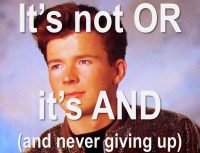It’s not ‘or’, it’s ‘and’.

Anyone who has witnessed the machination of senior leaders as they try to make clear the actions and behaviours that will drive positive change in an organistaion will be familiar with the “It’s not ‘or’, it’s ‘and’”. So what is such a phrase doing in research project?
Well it came about as John Wyver from illuminations was visiting project colleagues from BBC and IRT as they were embarking on some synchronisation experiments. John Wyver is leading on two of the prototype services being developed in 2IMMERSE, both are related to filmed theatre and the way it is presented, you can read about the At Home case here and the At School case here.
The question the experiments from the BBC and IRT was setting out to answer was ‘how closely synchronised should a script, displayed on a second screen device like a tablet, be to the action being displayed on the main TV screen?’ This synchronisation is, we must imagine, one of the more generous levels of synchronisation challenges in the project. At least it is generous when compared to the synchronisation of different camera angles on the same action, which could be a requirement of the MotoGP and Football prototypes (I suspect that this will require near frame accuracy, i.e 0.02-0.04 seconds) but it will be interesting to find out. Now, we haven’t got the answer yet for our script synchronisation problem. What do you think 1-2 seconds?
Important as this script synchronisation question is, other questions also need to be answered such as:
- how do users think they would use the synchronised script – i.e.. how often would they look at the script, and for how long?
- why might users look at a script? What benefits do they think it might have? Do they think it will help with audibility, will it help clarify meaning, or enhance the experience in some other way?
If script synchronisation is important, and I think it is, these question are also important if not critical. It’s not that we should answer only these motivation and utilisation questions though; you see it’s not OR it’s AND. And, as Rik says, never giving up.
READ MOREKISS: Keep It Simple, Stupid

It’s easy to find yourself going off on one – and useful to be called back.
That happened to me the other day when I was speaking to some BT TV colleagues about our work on the Sport in Pubs Prototype. These colleagues have been serving the Pub market with TV deals for years. They understand it.
I pitched what we are planning in 2-Immerse to this team. The response I got was cool, but helpful. In general I surmised they thought that there may be something in what we’re doing but the ideas we have had so far – and the way we present them, are not going to impress pub chains. This is the key stuff I think I need to remember:
1. “Our” customer is the landlord or the pub chain, not the punter
2. Keep it simple
3. A bad result for a landlord is for people to leave/(not enter) the pub because they can’t /(expect to not be able to) see the match. Ergo. Use all screen real estate to show the match not the “fluff” (stats, replays, manager cam, etc)
4. In pitching to pub chains try not to be too prescriptive. It may be worth telling the story of football in pubs (1990 England vs Germany newspapers reporting ‘the pubs will be empty’; B&W TV on the bar; projection TVs, very large screens; and now multiple flat panels giving lien of sight to all corners of a pub) and emphasise that what we want to do is to further improve the experience of watching football out of the home.
5. The personal mobile screen may be valuable for the “fluff”.
6. Experiences that are bespoke to the user, and in particular to the user in that pub, may make sense and it may be good to concentrate on developing such experiences.
7. Different audio (no commentary, selectable commentary) were better received as ideas than the video based stories in the deck.
8. Do try and build stories that may enhance the social nature of watching Sport in a pub
We must adapt our current use case to fit with this…
All feedback, I was once told, is a gift.


